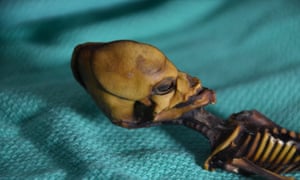Back in 2003, In Chile’s Atacama
Desert, a miniature, deformed, mummified humanoid skeleton was found wrapped in
a piece of white cloth. As one can imagine this caused a plethora of perplexing
questions and many equally as perplexing claims to answer them. The widest spread
and outlandish of which was that this small skeleton, nick named “Ata”, was some
sort of ancient alien who passed away long ago. With a back story like that, this
little specimen was sold around the world between private collectors, all of
whom paid a pretty penny to get their hands on it. Yet it wasn’t until 2013 that
a scientist, Garry Nolan, and his team at Stanford University, decided to conduct
an actual DNA analysis of Ata in the hopes of unraveling the mysteries surrounding
it.


What they found was that
Ata was not an ancient alien at all, but in fact a human female who exhibited skeletal
malformations, along with a condition called congenital diaphragmatic hernia, which
results in an improper formation of the diaphragm. Because Ata exhibited these
defects, this would mean that she would have been a still born or must have died
immediately after birth, which would also explain the care displayed in her wrapping
and burial. Furthermore, the analysis uncovered that Ata’s DNA closely resembled
that of other Chileans, and that she most likely died approximately 40 years
prior. So, although Ata may not have been an alien corps, but instead a human child
with mortal birth defects, the discovery of the mutations believed to have aged
her bones could potentially aid in the development of therapies and drugs that
can help drive bone development in people with skeletal problems. Thus, giving a
happy ending to this seemingly tragic tale.
The link to this article is: https://www.theguardian.com/science/2018/mar/22/genetic-tests-reveal-tragic-reality-of-atacama-alien-skeleton
And for Ata’s original study conducted at Stanford, use
this link: http://siriusdisclosure.com/evidence/atacama-humanoid/
No comments:
Post a Comment